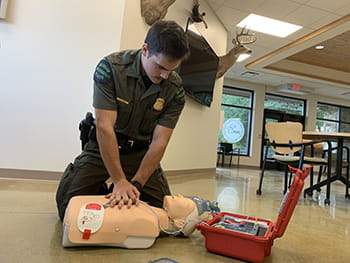The web Browser you are currently using is unsupported, and some features of this site may not work as intended. Please update to a modern browser such as Chrome, Firefox or Edge to experience all features Michigan.gov has to offer.
Training Academy #12: Week 5
Oct. 2-6, 2023
Author: PCO Kyle Romzek, Ruth, Michigan
Photo caption: A probationary CO delivers chest compressions to a mannequin while performing CPR and using an automated external defibrillator. AEDs administer loud instructions, telling a rescuer what to do while also delivering shocks to the heart of the person being treated. AEDs can be found in most public facilities, such as libraries, grocery stories and shopping centers.
For Week 5 of Training Academy #12, we were back at the DNR Rose Lake Shooting Range in Bath. The week was dedicated to first aid and survival tactics: techniques and skills to defend yourself in physically threatening situations.
Monday started with review of the DNR Law Enforcement Division’s Taser policy and procedures. In the afternoon we met with survival tactics instructors who introduced us to the functions and features of the X26P TASER that each of us were issued. Once everyone was comfortable and familiar with the Tasers, we completed a series of group and individual scenarios. Each scenario consisted of an intense altercation with an instructor (wearing a protective suit) that we had to resolve. After the scenario was completed, each student received feedback about what they did well and how to improve in the future.
Tuesday consisted of hand-to-hand self-defense training and proper handcuffing techniques. We completed several different handcuffing scenarios and were taught different techniques that would be beneficial in various situations. In the afternoon we focused on self-defense that could help protect us in physical altercations.
Wednesday was more self-defense training, consisting of different take-down moves that tied into the handcuffing techniques we learned Tuesday. We were also taught different strikes with our hands, elbows, hips, legs and feet. The instructors’ main goal was to teach us techniques to safely complete an arrest without injuring ourselves or the person being arrested.
Photo caption: Probationary COs practice applying a tourniquet on each other before they complete a more fast-paced scenario.
Thursday and Friday were dedicated to first aid. Thursday morning covered policy and procedure, bloodborne pathogens, CPR, automated external defibrillators and tourniquets. In the afternoon we focused on tourniquets, how and when to use them and how beneficial they can be. We trained by putting tourniquets on ourselves and our partners. While blindfolded, we had to find a wound on our partner and put a tourniquet on them while only using one hand.
Photo caption: During a first aid scenario, a probationary CO, followed by a first aid instructor, runs to a victim who is wounded. PCOs complete scenarios in which they arrive to a scene, unsure what to expect, and must use their training from the week to successfully complete the scenario.
Friday was used for medical scenarios, consisting of unresponsive adults, children and choking subjects, as well as a mass-casualty situation. Instructors stressed the importance of knowing what equipment we carry and how to use it. They also had us plan what first aid equipment we should carry with us for daily use and in emergencies, such as an event involving multiple casualties. I can honestly say that I feel much more confident in myself to provide medical treatment. Most of my prior medical training focused on treating other people; this training focused on how to save yourself, which was never really talked about before. This first aid training was the most beneficial medical training that I received thus far.
Photo caption: A first aid instructor watches a probationary CO assess a victim with multiple gunshot wounds in a training scenario. Instructors closely observe all PCOs in scenarios so they can provide constructive feedback.



